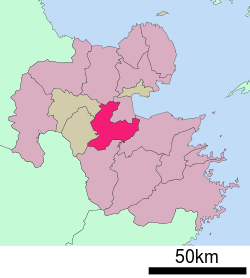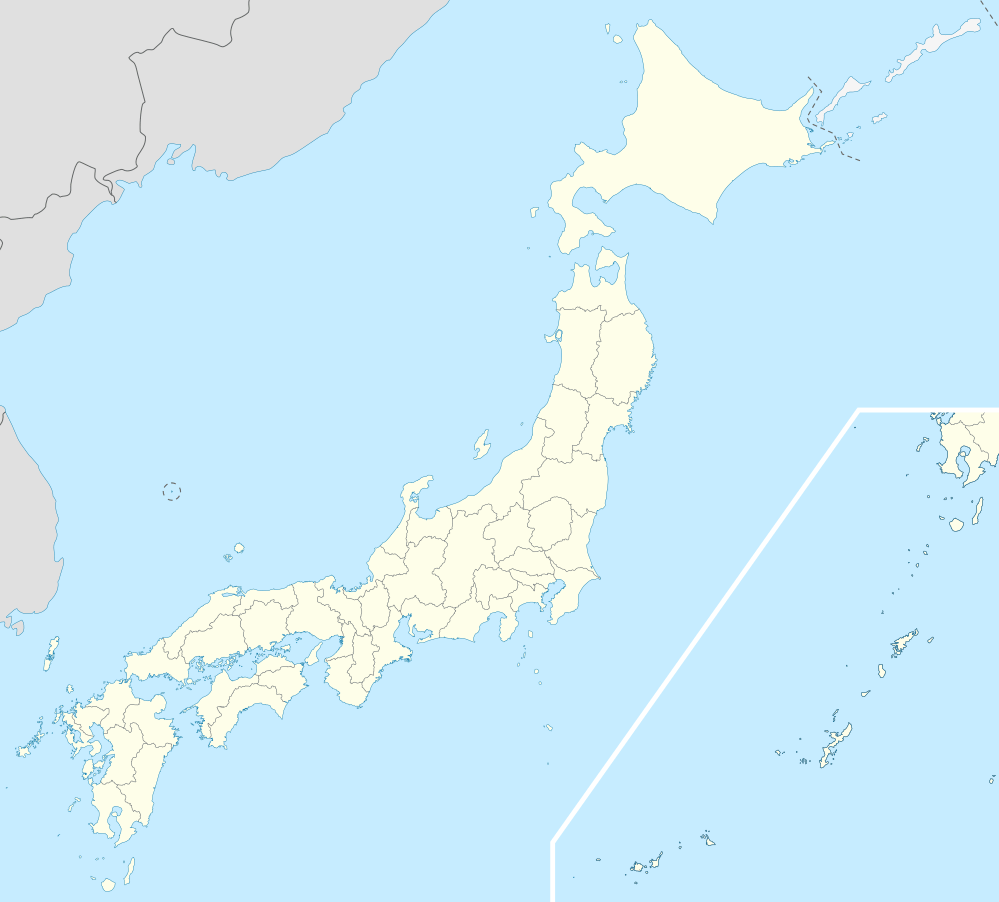Yufu
Yufu (由布市, Yufu-shi) is a city in Ōita Prefecture, Japan. The modern city of Yufu was established on October 1, 2005, from the merger of the towns of Hasama, Shōnai and Yufuin (all from Ōita District).
Yufu 由布市 | |
|---|---|
Flag Chapter | |
 Location of Yufu in Ōita Prefecture | |
 Yufu Location in Japan | |
| Coordinates: 33°11′N 131°26′E | |
| Country | Japan |
| Region | Kyushu |
| Prefecture | Ōita Prefecture |
| Area | |
| • Total | 319.32 km2 (123.29 sq mi) |
| Population (June 1, 2019) | |
| • Total | 33,120 |
| • Density | 100/km2 (270/sq mi) |
| Time zone | UTC+9 (JST) |
| City hall address | 302 Kakihara, Shōnai-chō, Yufu-shi, Ōita-ken 879-5498 |
| Website | www |
Yufudake in the morning
As of 1 June 2019, the city has an estimated population of 33,120, and a population density of 104 persons per km².[1] The total area is 319.32 km².
Geography
Yufu is located in central Ōita Prefecture, surrounded by mountains, such as Yufudake (1,583 m), Shirogatake, and Tokiyama. The Ōita River created an alluvial fan, where farming is done. Part of the city is named as a portion of Aso Kujū National Park. Also, Yufu is known for its many hot springs.
Rivers
- Ōita River
- Yufu River
- Iwaki River
Lakes
- Lake Kinrin
- Lake Yamashita
History
- 1889: Villages Anan, Higashishōnai, Nishishōnai, Minamishōnai, Asono, Tani, Yufugawa, Yunohira, Iwakigawa, and Hasama are created in Ōita District. Kitayufu, Minamiyufu, and Yunohira are created in Hayami District.
- 1899: Yunohira village is moved to Ōita District.
- 1936: Minamiyufu and Kitayufu are merged, creating Yufuin village.
- 1948: Yufuin village is renamed Yufuin town.
- 1950: Yufuin town is moved to Ōita District.
- 1954: Hasama, Tani, Yufugawa, and Iwakigawa is merged, now named Hasama village. A month later, Anan, Asono, Higashishōnai, Minamishōnai, and Nishishōnai are united. It is named Shōnai village.
- 1955: Yufuin and Yunohira are merged. The new town is named Yufuin, but the character for "Yu" is different from the one before. In the same year, Shōnai village is renamed Shōnai town and Hasama village is renamed Hasama town.
- 2005: Hasama, Shōnai, and Yufuin are united, the new city named Yufu.
gollark: Each pair of "cores" shares a bunch of resources, so it isn't really as fast as an actual "core" in other designs, and I think their IPC was quite bad too, so the moderately high clocks didn't do very much except burn power.
gollark: See, while the FX-4100 is allegedly a fairly high-clocked quad-core, this is misleading. AMD's Bulldozer architecture used "clustered multithreading", instead of the "simultaneous multithreading" on modern architectures and also Intel's ones at the time.
gollark: (as this is based on a tower server and not a rack one, you might not even have ridiculously noisy fans in it!)
gollark: Anyway, I don't think this computer is worth £300, inasmuch as you could buy an old server with a Sandy Bridge era CPU for let's say £120, buy and install an equivalent GPU (if compatible, you might admittedly have some issues with power supply pinout) for £100 or so, possibly upgrade the RAM and disks for £50, and outperform that computer with £30 left over.
gollark: I did *not* just pluck £90 out of nowhere, since even if there wasn't the whole silicon shortage going on, used prices aren't conveniently documented by the manufacturer somewhere.
References
- "Official website of Yufu city" (in Japanese). Japan: Yufu City. Retrieved 17 April 2017.
External links
| Wikimedia Commons has media related to Yufu, Oita. |

- Official website (in Japanese)
This article is issued from Wikipedia. The text is licensed under Creative Commons - Attribution - Sharealike. Additional terms may apply for the media files.